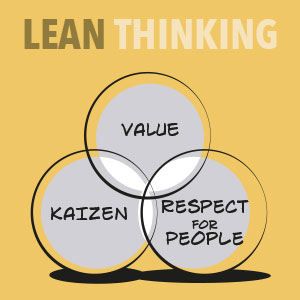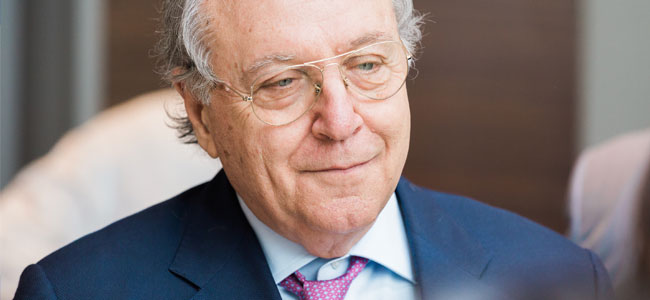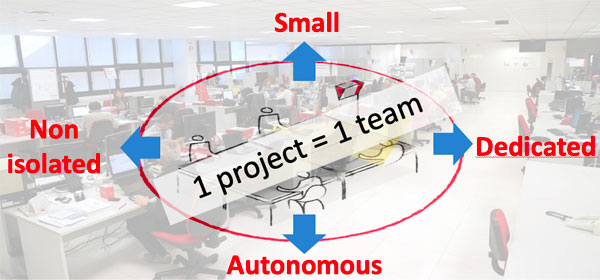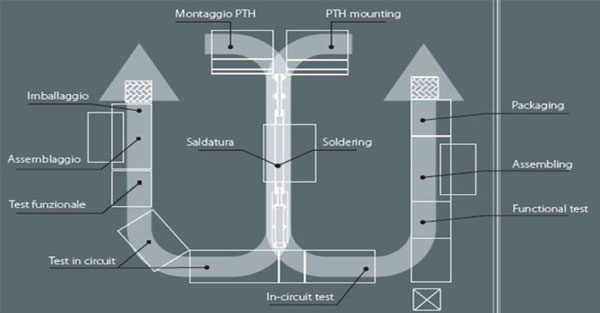Lean at CAREL
Why lean?
 Lean thinking is the managerial philosophy that CAREL has chosen to adopt. Originally called Toyota Production System (TPS) in Japan after World War II, lean thinking proposes an approach whose cornerstones include maximising value for the customer (Value) by continuously improving business processes (kaizen) and developing the people that are part of it (Respect for People). CAREL decided from the outset to adopt lean management not as a project with a beginning and an end, or as a set of techniques and methods to be introduced, but rather as a philosophy, a creed that permeates its strategy, activities, processes and people.
Lean thinking is the managerial philosophy that CAREL has chosen to adopt. Originally called Toyota Production System (TPS) in Japan after World War II, lean thinking proposes an approach whose cornerstones include maximising value for the customer (Value) by continuously improving business processes (kaizen) and developing the people that are part of it (Respect for People). CAREL decided from the outset to adopt lean management not as a project with a beginning and an end, or as a set of techniques and methods to be introduced, but rather as a philosophy, a creed that permeates its strategy, activities, processes and people.
Value
Lean principles are based on identifying and maximising value for the customer. Anything that does not generate value from the customer’s point of view, in other words, anything that the customer is not willing to pay for, is considered waste (muda) that can be eliminated or reduced to a minimum. By focusing solely on the processes and activities that generate value and putting the customer first, whether the end customer or an internal customer, quality increases, lead times are shortened, the service level improves and resources are used in a more efficient and flexible way.
Kaizen
Kaizen is a Japanese word that means to change for the better, and is used in lean jargon to indicate continuous improvement. The key to understanding the concept is the word “continuous”: improvement is not something that is done sporadically or implemented by specific employees or consultants; improvement is continuous because it involves everyone, always, everywhere. Kaizen is based on small incremental improvements, a progressive advancement by objectives, and involves the entire company. At CAREL kaizen refers to the entire organisation, from top management to blue collar workers, continuously seeking improvements by identifying problems and solving them.
Respect for people
Lean management aims to involve people by placing them at the centre of improvement activities. Each employee, in addition to carrying out their assigned tasks, is also encouraged to improve them: who better than the people who work in the process has the skills to improve the process itself? CAREL has decided to accompany its people on a path of growth, equipping them with the skills and tools (see Lean Academy Program) and the time to devote to improvement. We have chosen to promote experimentation and adoption of the scientific.
Lean as a strategy
Lean thinking has become such an important element for CAREL that the company has also decided to manage development of the strategy, as well as how it is updated and deployed in the organisation, applying a lean technique called hoshin kanri, and a visual tool, the X-Matrix.
Hoshin kanri is a Japanese term that identifies a strategic planning process to ensure that the mission, vision, objectives and annual targets are clearly shared and communicated throughout the organisation, so that everyone, from directors to blue collar workers, can contribute to achieving these through aligned and coherent projects and activities. The underlying principle is that the strategy, developed and updated by top management, should not remain hidden or secret from the rest of the organisation, as everyone has a specific role in implementing it. In other words, the basis is that every single employee has a wealth of skills and experience such that their contribution, even if minimal and/or limited to the specific task, can help add value.
X-Matrix is the tool that CAREL has adopted to deploy its strategy.
The tool is used and interpreted clockwise, starting from the corporate Vision and Mission statements. Only once having defined the company’s ideals, Vision and reason for existing, or the purpose it aims to have on the market (Mission), is it possible to identify (a few) strategies: strategies are high-level long-term plans that will guide the company’s path, at least for the following five years.
Strategies are then detailed as tactics, i.e. medium-term plans with more concrete objectives, and these in turn are further broken down into projects. Projects have a time frame ranging from 3 months to 2 years: projects are assigned specific resources, deadlines and quantifiable and measurable objectives through project indicators (KPIs), and are reported in the appropriate section of the tool.
Projects are “distributed” throughout the organisation to Project Managers, who manage them using the project A3; periodically, they will report the progress of the project to Management using an alignment mechanism called catchball.
X-M can also be used to make correlations between strategies, tactics, projects and KPIs, in order to ensure that initiatives meet the company’s strategic needs.
History of lean at CAREL
Lean was first implemented at CAREL back in 2007, the year when the company officially declared its intention to adopt changes according to lean philosophy, making it a cornerstone of its future growth strategy.
The President and founding partner, Mr. Luigi Rossi Luciani, explained the origins of CAREL’s lean journey:

"
To understand the importance of the dissemination and application of lean management in our company, we need to go back a few years, at the beginning of our journey of “transformation” into a lean company. Our first contact with the principles and techniques of lean thinking dates back to 1994, during a seminar on the compatibility between lean philosophy and Veneto culture at Villa Braida (Treviso). This study group, promoted by Unioncamere and the Veneto Federation of Industrialists, was supported principally by the University of Padua faculty of Management Engineering, based in Vicenza. The workshop featured weekly sessions spanning 6 months, and saw the participation of leading academics on the subject, such as Prof. De Toni, Prof. Filippini, Prof. Forza and Prof. Vinelli, as well as a small number of interested businesspeople. The event stimulated me to transform CAREL into a lean company.
At the time, CAREL was preparing to close its financial year with rapidly growing sales and economic results. The company was in perfect health from an economic-financial point of view, yet although the situation was not critical, there were some signs of weakness that needed to be addressed: across the group we started to see less proactivity due to a sense of security coming from success, there were difficulties in communicating information, cases of manufacturing delays to customers were increasing, and the new product development process was taking longer and longer due to a lack of coordination between different functions.
The need to change was evident. To overcome resistance to change, a “sense of urgency” had to be created in order to ensure that everyone took part in the transformation. In July 2007, the company officially declared its intention to implement a change in accordance with lean philosophy, indeed making it a strategy. Aware of the complexity of the project, yet at the same time determined to carry it forward, we established a “loyalty pact” with employees: the company was willing to help those who faced difficulties in the change, while at the same time was fully determined to undertake lean transformation."
 While in most companies that embrace lean thinking, change usually starts in the Production area, CAREL began with transactional processes, i.e. R&D. The main innovations were the introduction of a new matrix-based organisation and a change in approach to the management of new product development projects, in particular with the introduction of compact multifunctional teams that work on one project at a time from a one-piece flow perspective. The results were very encouraging: project development times fell by 20%, delays in consigning deliverables decreased by 60%, while the quality of output and employee motivation increased.
While in most companies that embrace lean thinking, change usually starts in the Production area, CAREL began with transactional processes, i.e. R&D. The main innovations were the introduction of a new matrix-based organisation and a change in approach to the management of new product development projects, in particular with the introduction of compact multifunctional teams that work on one project at a time from a one-piece flow perspective. The results were very encouraging: project development times fell by 20%, delays in consigning deliverables decreased by 60%, while the quality of output and employee motivation increased.
 On the strength of these results, in 2009 Operations began to be transformed from a lean perspective, introducing value streams, one-piece flow lines, pull processes through kanban management, use of the double bin system on production lines, training lines for hiring new operators, time devoted to 5S activities, stand-up meetings, etc. In this area too, the results were surprising: for every hour invested in continuous improvement in production, three were saved in cycle time, waste decreased by 59% and defects by 50%, revenues per square metre increased by 47%, and the service level by 10%.
On the strength of these results, in 2009 Operations began to be transformed from a lean perspective, introducing value streams, one-piece flow lines, pull processes through kanban management, use of the double bin system on production lines, training lines for hiring new operators, time devoted to 5S activities, stand-up meetings, etc. In this area too, the results were surprising: for every hour invested in continuous improvement in production, three were saved in cycle time, waste decreased by 59% and defects by 50%, revenues per square metre increased by 47%, and the service level by 10%.
In the following years, the lean transformation process continued and extended to other functions, introducing new techniques and tools. From visible planning and extended visual management, to hoshin kanri for strategic deployment, PDCA, A3 Thinking and TPM. Today there are several projects underway in different fields (see Projects).
In recent years, CAREL has established itself as a reference point for the academic world in relation to lean philosophy. Universities, business schools and masters courses rely on CAREL to train their students. The company continually hosts on-site visits and receives requests for further information for individual research theses or to share experiences with other companies.
